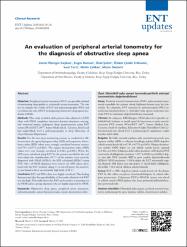An evaluation of peripheral arterial tonometry for the diagnosis of obstructive sleep apnea

Göster/
Erişim
info:eu-repo/semantics/openAccessTarih
2018Yazar
Coşkun, Zerrin ÖzerginDursun, Engin
Şahin, Ünal
Erdivanlı, Özlem Çelebi
Terzi, Suat
Çeliker, Metin
Demirci, Münir
Üst veri
Tüm öğe kaydını gösterKünye
Coşkun, Z.Ö., Dursun, E:, Şahin, U., Erdivanlı, Ö.Ç., Terzi, S., Çeliker, M., Demirci, M. (2018). An evaluation of peripheral arterial tonometry for the diagnosis of obstructive sleep apnea. ENT Updates, 8(1), 19-26.Özet
Objective:Peripheral arterial tonometry (PAT) as a portable method of monitoring sleep quality is a relatively recent innovation. The aim was to compare the results of PAT and polysomnography (PSG) and to evaluate the role of PAT in diagnosing obstructive sleep apnea syndrome (OSAS). Methods: This study included adult patients who admitted to ENT clinic with OSAS complaints (excessive daytime sleepiness, snoring, and witnessed apnea), undergone sleep monitorization using PAT system (WatchPAT 200TM; Itamar Medical Ltd., Caesarea, Israel) and had single-blind, level 1 polysomnography at sleep laboratory of Chest Diseases Department. Results: For the two sleep monitoring sessions as conducted at different times: the apnea-hypopnea index (AHI) and respiratory disturbance index (RDI) values were strongly correlated between sessions (r=0.749, r=0.753; p<0.001). The oxygen desaturation index (ODI) values were very strongly correlated (r=0.861; p<0.001). When the AHI scores calculated using PAT for the patients enrolled in the trial were taken into consideration; 89.7% of the patients were correctly diagnosed with OSAS (AHI?5); for RDI calculated (RDI?5) using PAT, 100% of OSAS diagnoses were correct; for AHI values calculated with the PAT method, taking 15 as cut-off point, the sensitivity was found to be at an extremely high level of 96.1%. Conclusion: PAT and PSG values were highly correlated. This finding demonstrated that the reproducibility of the results obtained with PAT was also high. This study shows that PAT can be used as a screening test for OSAS and in a group of patients who are highly suspected for OSAS. Amaç: Periferik arteriyel tonometrinin (PAT), uyku monitörizasyonunda ta?›nabilir bir yöntem olarak kullan›m› k›smen yeni bir yöntemdir. Bu çal›?mada, PAT sonuçlar› ile polisomnografi (PSG) sonuçlar›n›n kar?›la?t›r›lmas› ve obstrüktif uyku apnesi sendromu tan›s›nda PAT’›n rolününün de¤erlendirilmesi amaçland›. Yöntem: Bu çal›?maya KBB klini¤ine OSAS ?ikayetleri (gündüz uykululuk hali, horlama ve tan›kl› apne) ile ba?vurmu? ve uyku monitörizasyonu PAT sistemi (WatchPAT 200TM; Itamar Medical Ltd., Caesarea, ‹srail) ile yap›lm›?, daha sonra Gö¤üs Hastal›klar› Uyku Laboratuvar›nda kör olarak level 1 polisomnografi uygulanm›? eri?kin hastalar dahil edildi. Bulgular: ‹ki farkl› zamanda yap›lm›? uyku monitörizasyonunda apne hipopne indeksi (AHI) ve solunum bozuklu¤u indeksi (RDI) de¤erleri yüksek oranda korele idi (r=0.749, r=0.753; p<0.001). Oksijen desatürasyon indeksi (ODI) de¤eri ise çok yüksek oranda korele saptand› (r=0.861; p<0.001). Çal›?maya dahil edilen hastalar›n AHI skorlar› PAT yöntemiyle ölçüldü¤ünde; hastalar›n %89.7’si OSAS için (AHI?5) do¤ru tan› ald›; PAT testinde, RDI’ye göre yap›lan de¤erlendirmede (RDI?5) OSAS tan›lar›n›n %100’ü do¤ru idi; PAT yöntemiyle yap›lan ölçümde AHI de¤eri için e?ik de¤eri 15 olarak kabul edildi¤inde, duyarl›l›k %96.1 olarak oldukça yüksek bulundu. Sonuç: PAT ve PSG de¤erleri yüksek oranda korele idi. Bu durum PAT ile elde edilen sonuçlar›n tekrarlanabilirli¤inin de yüksek oldu¤unu göstermi?tir. Çal›?mam›z PAT’›n OSAS’da tarama testi olarak ve yüksek oranda OSAS ?üphesi olan hasta grubunda kullan›labilece¤ini göstermektedir.
Kaynak
ENT UpdatesCilt
8Sayı
1Bağlantı
https://doi.org/10.2399/jmu.2018001001https://app.trdizin.gov.tr/makale/TXpBNE1UWXdNQT09
https://hdl.handle.net/11436/5768

















